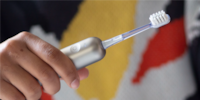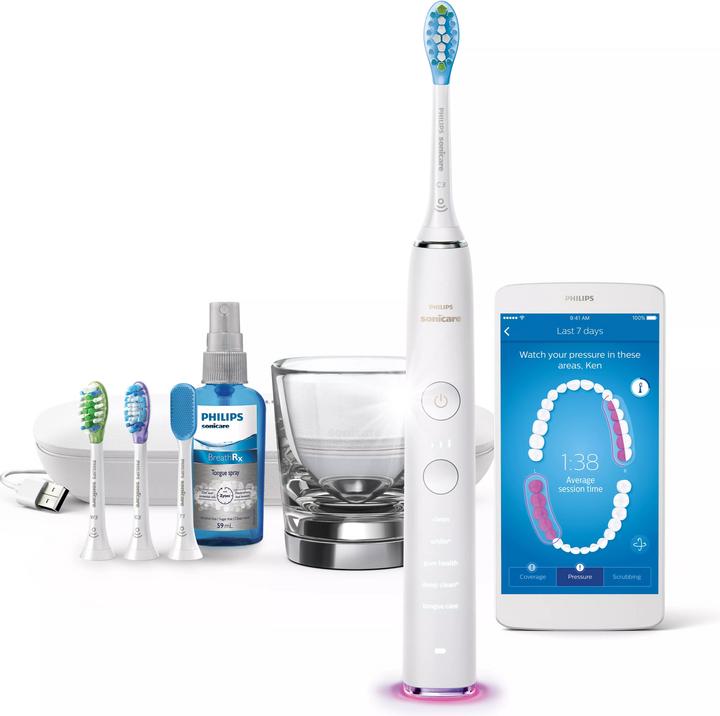

Philips DiamondClean Smart tested: the toothbrush with app control
Stylish design, high-quality accessories and lots of functions - Philips Sonicare DiamondClean Smart is one of the top models among sonic toothbrushes. But all this comes at a price. Does the electric toothbrush live up to it?
The model tested here is a further development of Philips' normal DiamondClean range. The addition "Smart" comes from the fact that this toothbrush is connected to an app on your smartphone via Bluetooth and thus provides all kinds of additional functions.
Design and functions
The handpiece of the toothbrush makes a positive impression as soon as you touch it. It has a good weight of around 140 grams. The surface is matt and therefore looks high-quality, but also feels very pleasantly soft. The toothbrush fits perfectly in the hand and looks as if it has been made from a single mould. The labelling on the brush is illuminated and is automatically activated when you pick it up. The different brushing modes can be seen in the lower section. When you attach a brush head, the toothbrush recognises the corresponding mode and highlights it. There is another button under the on/off switch to change the mode. Three bars are displayed between the switches, symbolising the current intensity (high, medium, low). At the very bottom, the brush has an LED ring that lights up whenever you press too hard while brushing.
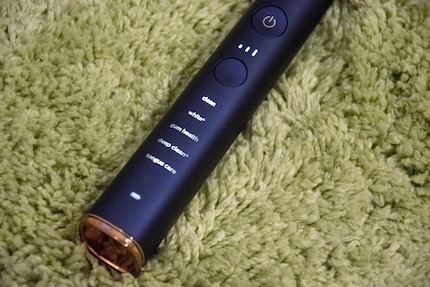
It's not just the toothbrush itself that looks high quality. The accessories are also impressive. The charging glass is particularly stylish. It is dishwasher-safe and thick-walled. The lower part is made of plastic and stands on the matching charging tray. After cleaning, simply place the brush back in the jar and it will be recharged by wireless charging through the coaster. The first full charge takes about a day. Then the built-in battery lasts for around two weeks.
The charging case is also practical for travelling. The travel case is covered with a textured rubber layer with a leather-like design. In addition to the toothbrush, it also has space for two brush heads. The USB charging cable is wound into the base of the case. The brush remains in the case while charging. When closed, a magnet holds the lid in place. Unfortunately, the stylish case is not quite perfect. The inner part is made of plastic and the hinge side is not very durable when frequently opened and closed.
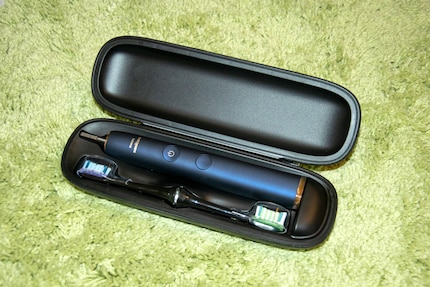
In addition to the handpiece, two brush heads fit into the travel case.
The scope of delivery also includes four brush heads and a transparent case for storing them. Included are the "C3 Premium Plaque Defence" heads for daily cleaning, "G3 Premium Gum Care" forcleaning, "W3 Premium White" for whiter teeth and the "TongueCare+" tongue brush.
Strong brushing performance
As mentioned, the toothbrush automatically recognises the brushing mode as soon as you attach the corresponding head. Then all you need to do is apply toothpaste and start brushing with a press of the on/off button. The bristles oscillate extremely quickly and, according to the manufacturer, achieve up to 62,000 movements per minute. If you press too hard or move the brush too quickly, the handpiece vibrates and the LED ring at the end lights up red.
If you connect the toothbrush to your smartphone via Bluetooth, you can access even more functions via the Sonicare app. For example, you can see on a model which area you are currently brushing. Section changes are indicated by the handpiece vibrating. The app also counts the number of times the brush head has been used and informs you when it's time to buy a new head. A symbol for this also lights up in the lower part of the toothbrush. Philips also wants to sell a plan in the app that automatically supplies you with new heads when they need to be replaced. After brushing, there is an evaluation that uses a dentition diagram to show me which areas I should pay more attention to next time. For example, I may have forgotten an area or not brushed long enough, scrubbed too hard or applied too much pressure. This even spurs me on to do better next time.
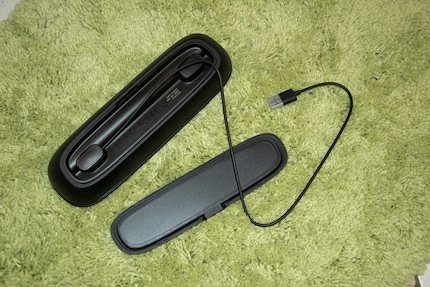
The case is also a charging cradle. The USB cable is located in the base.
The next time you visit the dentist, you can show the app and set three focus areas for your brushing behaviour. To do this, click on the teeth with the corresponding problem in a dental image. You can enter tartar, areas with bleeding gums, receding gums and tooth decay.
App connection could be better
What should be a good idea unfortunately has some weaknesses in practice. The app works quite well as a toothbrushing coach: depending on which brush head I have on, I can see on the display which part of my teeth I should be brushing and get tips on where I should brush better next time. There are also warnings if I move the brush too quickly or apply too much pressure. However, when testing, it was not always possible to connect to the app via Bluetooth.
Under the menu item "Goals", I set what I would like to achieve when brushing. It's not really convincing, because in the end the programme just tells me to use a certain head. You can also create your own goals, but only three of the pre-set options can be used for this. These are, for example, "Brush twice a day", "Clean interdental spaces" or "Use brush head XY at least once a day". After brushing, the app asks whether you have used dental floss for the interdental spaces or mouthwash and creates an evaluation from this. That's quite nice, but not smart enough for me. I would like to use the diagram of my mouth with the centres of gravity as a basis and the toothbrush should then tell me how to brush. But we don't seem to have got there yet.
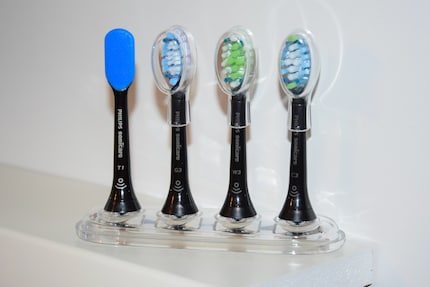
Depending on which brush you put on, the toothbrush recognises one of five suitable modes and sets this automatically.
The "Solutions" menu, which tells me in English that I can get quick answers and recommendations for my brushing behaviour from a dentist via a photo, causes confusion. An analysis is available for ten dollars ("Prices may vary in your country") or 35 dollars. Personal data must also be released for this. That seems suspicious to me and I don't use it.
Overall, using the app is not very practical. I can never find the point I'm looking for. I can't look at my statistics from the last few days in detail and the translation is a bit off in some places. For example, the app tells me that I need to brush for longer next time in places that are highlighted in white in a denture graphic. What is meant, however, are the areas highlighted in yellow. In addition, although the toothbrush has position sensors and recognises approximately how I am holding it in my mouth and therefore where I am currently brushing, these values are not exact, making the instructions invalid.
Conclusion: I don't really need the app
The smart toothbrush from Philips impressed with its very good cleaning performance when tested. Plaque is thoroughly removed. If you are prepared to spend this much money on a toothbrush, you get a high-quality model with practical accessories and many functions. Philips could only improve the app. If you can do without the latter, you can save money by buying the conventional version of this toothbrush.

Most of the time I'm living between bits and bytes, testing alternative Android operating systems and trying to make my life smarter with Open Source technology - always with a focus on privacy and data protection. When I'm not testing cool gadgets, I'm developing video games, writing stories and playing the accordion.
